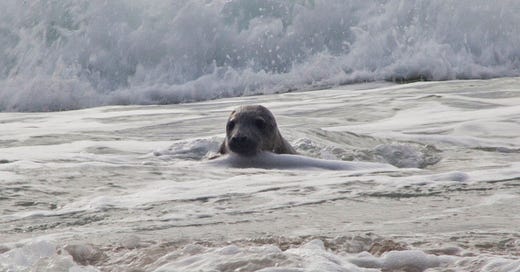Everyone likes a secret beach. But do you know who really likes a secret beach? Nudists and grey seals.
Both feature on this walk. More than 100 of one, only one of the other – in the ratio you might hope.
After passing the easily missed path that leads precipitously down the cliffside to the nudist beach, we pause at a viewpoint a little further along and look out on the chilly autumn ocean below. A bare bottom breaches the surface of the water.
If that’s a surprise at this time of year, the beach bums at our destination are not.
It’s peak pupping season for Cornwall’s colony of grey seals and this spot – inaccessible from land – is one of their favourite places to haul out and rest or give birth. Today, a rough count easily passes three figures.
It looks a little like the morning after the night before as bodies litter the sand, some flopping from side to side, others lying on their backs and clutching their bellies. A mournful wail echoing around the high walls of the cove adds to the sense of 9am on New Year’s Day.
The more active stretch into various yoga positions: locust pose, sphinx pose, seal-with-a-tummy-full-of-fish pose.
If ever a bunch of creatures look like they need a ‘Do not disturb’ sign it’s these seals. Sadly, it seems that’s exactly what they do need.
Recorded disturbance of marine mammals in Cornwall has soared in recent years, partly through greater awareness and reporting but also because of boats, paddleboards and drones.
Serious disturbance is defined as an incident where hauled-out seals return to the water as a result of human activity. In the worst cases, they do so in such a hurry that they injure themselves on rocks. But seals are easy to disturb – if one so much as looks at you then you’ve done it.
That’s why high on the cliff above this cove is the best place to watch them. As long as you keep noisy children, dogs and uncles under control, there’s little chance of disturbing the seals.
A male at the back of the beach, slightly apart from the crowd, shuffles his huge, scarred body so he can rest his head on a rock. That bull head and its long, Roman nose is one of the ways you can tell this seadog is male: while he resembles an English bull terrier, females have the round head and wide eyes of a labrador who’s seen you with the cheese grater.
Another difference is the markings. Male fur is dark and relatively plain, females are lighter and blotchier. Each pattern is unique. In the way you might look for shapes in clouds, volunteers for the Seal Research Trust study photos to pick out images in the markings that enable them to identify individual seals.
Less pleasing patterns are the deep, dark and dreadful scars around the necks of a couple of the females. It’s probably a result of time spent entangled in lost or discarded fishing gear. But even plastic flying rings – those frisbees with a hole – are a risk, particularly to playful young pups who put their heads through them. Many shops in Cornwall no longer sell them.
I call this a secret beach but, to be honest, it’s one of Cornwall’s worst-kept secrets. I think it’s a secret worth trying to keep though.
Forty per cent of the world’s population of grey seals live around the UK coast, but that’s a total of just 120,000 – less than half the number of red squirrels, the pin-up of endangered UK animals. The naked truth is, they don’t get half as much respect as they should.
Basking sharks seen on this walk: 0
Total basking sharks seen to date: 0





It must be wonderful to see the colony like that. It's shocking how much disturbance of seals (and other animals) has risen recently.
Loved this piece, and very glad of the ratio! A grey seal pup has just taken to hanging out on the path of my daily walk - it is almost spherical and has the most gorgeous moon eyes. Its favourite way to pass time seems to be rolling on its back with its flippers waving in the air. Amazingly (and brutally) I just watched a pod of orca kill a seal this morning.